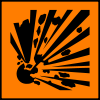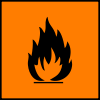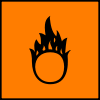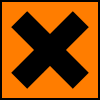European hazard symbols
This article needs additional citations for verification. (July 2018) |
European hazard symbols for chemicals are pictograms defined by the European Union for labelling chemical packaging (for storage and workplace) and containers (for transportation). They are standardised currently by the CLP/GHS classification.[1]
GHS hazard pictograms
[edit]- The European Union CLP Regulation (for "Classification, Labelling and Packaging") was introduced as EC Regulation 1272/2008. It is based on the GHS system, to secure for "physical, health and environment hazards".[2][1][3]

- The European Agreement concerning the International Carriage of Dangerous Goods by Road (ADR) fixed harmonised pictograms for transportation. Vehicles carrying dangerous goods have to be fitted with orange signs, where the lower number identifies the substance, while the upper number is a key for the threat it may pose.
Chemical warning signage
[edit]Directive 92/58/EEC provides several safety signs for identifying dangerous materials and areas where they are handled and stored.[4]
- Directive 92/58/EEC Warning Signage
-
Flammable material
-
Explosive material
-
Toxic material
-
Corrosive material
-
Oxidant material
-
Harmful or irritant material
(Withdrawn 2014)[5]
Former hazard pictograms (1967–2017)
[edit]The previous hazard symbols for chemicals, were introduced in the Directive Directive 67/548/EEC, in 1967, and required to be adopted no later than 1 January 1970.[6] The symbols were also included as a part of Directive 1999/45/EC.[7] The symbols were replaced from 1 December 2010 to 1 June 2017, via a gradual phaseout.[1] After 1 June 2017, Directive 67/548/EEC symbols were no longer allowed to be used.[1]
From 1967 to 2017, these symbols were used for labeling containers and piping systems containing dangerous substances/mixtures. These symbols could also be used to identify areas where dangerous substances/mixtures were being stored in large quantities, as an alternative to the yellow triangular Directive 92/58/EEC warning signage.[4]
| Hazard pictogram & mention, code | Substances examples |
|---|---|
 Explosive (E) Explosive (E) |
TNT, acetone peroxide, nitroglycerin, picric acid |
 Extremely Flammable (F+) Extremely Flammable (F+) |
Hydrogen, acetylene, propane, butane, diethyl ether, carbon disulfide, acetaldehyde |
 Highly Flammable (F) Highly Flammable (F) |
Ethanol, acetone, gasoline, hexamine, methanol |
 Oxidizing (O) Oxidizing (O) |
Oxygen, potassium nitrate, hydrogen peroxide, nitric acid, potassium permanganate |
 Toxic (T) Toxic (T) |
Sulfuric acid, TNT, Nitroglycerin, carbon disulfide, methanol, ammonia, formaldehyde |
 Very toxic (T+) Very toxic (T+) |
Prussic acid, nicotine, carbon monoxide, white phosphorus |
 Harmful (Xn)[a] Harmful (Xn)[a] |
Hexamine, butane, naphtha, acetaldehyde |
 Irritant (Xi) Irritant (Xi) |
Sodium hypochlorite, acetone, ethanol |
 Corrosive (C) Corrosive (C) |
Sulfuric acid, Nitric acid, sodium hydroxide, ammonia, White phosphorus |
 Dangerous for the environment (N) Dangerous for the environment (N) |
Sulfuric acid, turpentine, lead, mercury, Crude oil |
Notes
[edit]- ^ The 'n' in Harmful (Xn) stands for the French word nocif (harmful) and the Italian word nocivo (noxious).
References
[edit]- ^ a b c d "Regulations (EC) No 1272/2008 of the European Parliament and of the Council of 16 December 2008 on classification, labelling and packaging of substances and mixtures, amending and repealing Directives 67/548/EEC and 1999/45/EC, and amending Regulation (EC) No 1907/2006". eur-lex.europa.eu. European Union. 31 December 2008. pp. 325–328. Retrieved 11 June 2024.
- ^ "Guidance on labelling and packaging in accordance with Regulation (EC) No 1272/2008" (PDF). echa.europa.eu. European Chemicals Agency. March 2021. Archived from the original (PDF) on 21 May 2023. Retrieved 11 June 2024.
- ^ "Globally Harmonized System of Classification and Labelling of Chemicals" (pdf). 2021. Annex 3: Codification of Statements and Pictograms (pp 268–385).
- ^ a b "Council Directive 92/58/EEC of 24 June 1992 on the minimum requirements for the provision of safety and/or health signs at work (ninth individual Directive within the meaning of Article 16 (1) of Directive 89/391/EEC)". Official Journal of the European Communities. 35: 34. 26 August 1992. Retrieved 22 August 2023.
- ^ "Directive 2014/27/EU of the European Parliament and of the Council of 26 February 2014 amending Council Directives 92/58/EEC, 92/85/EEC, 94/33/EC, 98/24/EC and Directive 2004/37/EC of the European Parliament and of the Council, in order to align them to Regulation (EC) No 1272/2008 on classification, labelling and packaging of substances and mixtures". Official Journal of the European Union. 57: 1–7. 5 March 2014. Retrieved 22 August 2023.
(a) warning sign 'Harmful or irritant material' is deleted.
- ^ "67/548/EEC - No. 196/1 - Council Directive of 27 June 1967 on the approximation of laws, regulations and administrative provisions relating to the classification, packing and labelling of dangerous substances". eur-lex.europa.eu. European Economic Community. 16 August 1967. pp. 236, 238. Retrieved 11 June 2024.
- ^ "Directive 1999/45/EC of The European Parliament and of the Council of 31 May 1999 concerning the approximation of the laws, regulations and administrative provisions of the Member States relating to the classification, packaging and labelling of dangerous preparations". eur-lex.europa.eu. European Union. 30 July 1999. p. 11. Retrieved 11 June 2024.
External links
[edit] Media related to Directive 67/548/EEC hazard symbols and GHS hazard symbols at Wikimedia Commons
Media related to Directive 67/548/EEC hazard symbols and GHS hazard symbols at Wikimedia Commons Media related to Directive 92/58/EEC Safety Signs and ISO 7010 safety signs at Wikimedia Commons
Media related to Directive 92/58/EEC Safety Signs and ISO 7010 safety signs at Wikimedia Commons






![Harmful or irritant material (Withdrawn 2014)[5]](http://upload.wikimedia.org/wikipedia/commons/thumb/5/56/EEC_Safety_Sign_1992_-_Harmful_or_irritant_material.svg/120px-EEC_Safety_Sign_1992_-_Harmful_or_irritant_material.svg.png)